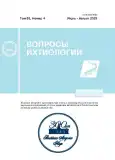Morphology of the Buccal and Opercular Sealing Apparatus in Mudskippers (Gobiidae: Oxudercinae)
- Авторлар: Tran L.X.1, Nguyen T.T.2
-
Мекемелер:
- College of Aquaculture and Fisheries, Can Tho University, Can Tho, Vietnam
- Mekong Delta Development Research Institute, Can Tho University, Can Tho, Vietnam
- Шығарылым: Том 63, № 4 (2023)
- Беттер: 375
- Бөлім: Articles
- URL: https://journals.rcsi.science/0042-8752/article/view/135200
- DOI: https://doi.org/10.31857/S0042875223040288
- EDN: https://elibrary.ru/RONIZJ
- ID: 135200
Дәйексөз келтіру
Толық мәтін
Аннотация
Although possession of the large bucco-opercular cavity and its utilization in the feeding, breathing, egg brooding, and burrowing activities are quite obvious in mudskippers, the apparatus of this structure is little known. In the present study, we examined the anatomy of the bucco-opercular sealing apparatus of four oxudercine gobies, Oxuderces nexipinnis, Scartelaos histophorus, Boleophthalmus boddarti, and Periophthalmodon septemradiatus, showing different degrees of terrestriality. The results show that the morphological modifications including the short and restricted gill openings, the membranes on the gill opercular edge (except O. nexipinnis), and the developed hyohyoideus 3 could serve to seal the gill openings. The possible movement of the ceratohyal, the relative height of the urohyal, and the developed geniohyoideus could function to seal the mouth. Contraction of the hyohyoideus 1 to 3 could compress the opercular cavity generating strong mud spitting, whereas activation of the dilator opercula, levator opercula, and a portion of the geniohyoideus may serve to expand this cavity enable sucking mouthful of water at slow speed. These morphological modifications are presumable to facilitate vital activities of mudskippers as transition onto land.
Негізгі сөздер
Авторлар туралы
L. Tran
College of Aquaculture and Fisheries, Can Tho University, Can Tho, Vietnam
Email: txloi@ctu.edu.vn
Вьетнам, Кантхо
T. Nguyen
Mekong Delta Development Research Institute, Can Tho University, Can Tho, Vietnam
Хат алмасуға жауапты Автор.
Email: txloi@ctu.edu.vn
Вьетнам, Кантхо
Әдебиет тізімі
Қосымша файлдар









